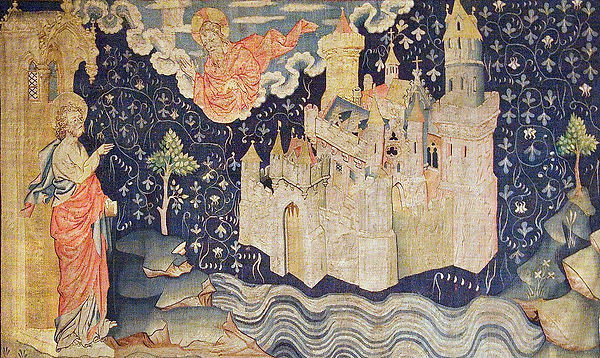Lesson 1
The Age of Shadows

Synopsis
How should we understand the relationship between the Old and the New Testaments? One way the Church Fathers explained this was by dividing the history of salvation into three stages: the time before Jesus’s first coming, the time after his second coming, and the period in between. These stages can be described as shadow, reality, and image. The age of shadows refers to the period of the history of Israel until the coming of Christ. This history contains biblical shadows of future realities.
God used these shadows to tell us about what he would do for us in the future, but these realities were not yet accessible to those who experienced them. We live in the age of the image, or the Church. The difference is that with these images (or sacraments) we already a we participate in realities they contain. We believe this even though we can't see nor explain it.
Learning Objectives
You will have successfully completed this lesson when you understand and can:
-
Describe the differences between the ages of shadow, image, and reality.
-
Explain the biblical origin of this terminology.
Introduction
In the previous lesson, we explained the unity of the Bible. As the word of man, the Bible is a collection of 73 different books written by various human authors over the course of centuries. But since God is its principal author, the Bible is also one book which tells one unified story. Because of this unity, we should read it as we read novels, that is, from beginning to end.
However, anyone who has attempted to do this well knows that this is no easy task. Many people struggle through the first books of the Bible and usually give up somewhere between Exodus and Numbers, bogged down by the long lists of genealogies, the censuses, the intricate descriptions of the tabernacle, the numerous prophecies of doom and gloom, and the archaic purity laws; or because they are shocked by its violence and immorality. Most eventually return to the New Testament because it is easier to understand and seems more relevant to their lives.
This problem is not new. One of the first heresies the Church had to address was Marcionism. Because Marcion of Sinope read the Bible literalistically, instead of literally, he thought the Old and the New Testaments contradicted each other. This led him to claim that the God of the New Testament was a different and higher deity than the god of the Jews and, consequently, to reject the entire Old Testament. However, the Church has always defended its importance.
The Old Testament is an indispensable part of Sacred Scripture. Its books are divinely inspired and retain a permanent value, for the Old Covenant has never been revoked. (CCC 121)
Christians venerate the Old Testament as true Word of God. (CCC 123)
How should we understand the relationship between the Old and the New Testaments? One way the Church Fathers explained this was by dividing the history of salvation into three stages: the time before Jesus’s first coming, the time after his second coming, and the period in between. These stages can be described as shadow, reality, and image.
The Age of Shadows
The age of shadows refers to the period of the history of Israel until the coming of Christ. This history contains biblical shadows of future realities. This terminology was taken from the Bible itself.
They serve a copy and shadow of the heavenly sanctuary. (Heb 8:5)
For since the law has but a shadow of the good things to come… (Heb 10:1)
By writing in this way, the author of Hebrews is saying that these things function like shadows. How does this comparison work? Normal shadows are dark areas that appear when opaque objects block light. Because of the way they are formed, their shape will correspond to the objects that made them, and we can therefore normally identify an object through its shadow. For example, can you determine which objects produced the following shadows?



Likewise, biblical shadows correspond in some way to future spiritual realities. That is why they are called that way. All biblical shadows were created by God, who, as the principal author of the Bible, imbued them with this deeper meaning. For example, when God instituted the priesthood through Moses, he already had Christ’s future priesthood in mind and modelled it accordingly. That is why the priests of the Old Testament are shadows of our eternal high priest, even though the Bible doesn’t describe them that way.
Indeed, the law appoints men in their weakness as high priests, but the word of the oath, which came later than the law, appoints a Son who has been made perfect for ever. (Heb 7:28)


The Old Testament high priest is a “shadow” of Jesus, the eternal high priest.
(Photos by Lawrence OP on Flickr)
Furthermore, because of the correspondence between objects and their shadows, we can often deduce things about an object by looking at its shadow. For example, what can you say about the three people who produced the shadows depicted in the following image?

By looking at their shadows, I would say that they are a family. Because of the shape and size of the bodies, I also think that the shadow on the left corresponds to the father, the one on the right to the mother, and the one in the middle to their son, who is about two years old and is holding his mother’s hand. The parents appear to be healthy, young adults.
Correspondingly, we can deduce things about the spiritual realities from their shadows in the Old Testament. For example, the author of Hebrews claims that Jesus Christ, our eternal high priest, must also offer a sacrifice because the priests of the Old Testament did so.
For every high priest is appointed to offer gifts and sacrifices; hence it is necessary for this priest also to have something to offer. (Heb 8:3)
This process of deduction is not simple because shadows are, by nature, indistinct and ambiguous. Much of the information about an object is lost in in its shadow. For example, it is impossible to determine the color of the people’s skin, eyes, and hair from the picture above. Neither can we see what they were wearing or are we given any clues as to their profession. In fact, they might not even be a family at all. They could be neighbors, friends, or a babysitter with her boyfriend. Shadows can, in fact, be so deformed, that it is impossible to recognize the object that produced them.
For example, the shadow in the following image appears to be of Michael Jackson, but the object that created it looks nothing like him.

Therefore, we have to be careful when interpreting Old Testament shadows. When reading the Bible, one must always keep in mind the principles of interpretation we studied in lesson 2.
The Age of Reality
The third age, the age of reality, refers to the time after Jesus’ second coming, when the fulness of the heavenly glory will be made known. We won’t need shadows anymore because we will see God as he is, as the apostles John and Paul tell us:
Beloved, we are God’s children now; it does not yet appear what we shall be, but we know that when he appears we shall be like him, for we shall see him as he is. (1 Jn 3:2)
For now we see through a glass, darkly; but then face to face: now I know in part; but then shall I know even as also I am known. (1 Cor 13:12)
.jpg)
“La Jérusalem celeste”, extracted from the Tapestry of the Apocalypse of the Castle of Angers, France.
The Age of the Image
We live in the second stage, the age of images, which is also called the age of the Church. This is the period between the shadows of the past and realities of the future. In this age, we are given “images” of heavenly realities. An image is a more realistic representation of something, so we can know much more about an object from its image—think of a portrait or photograph— than from its shadow. For example, even though the following photograph is in black and white (except for the boots), we can clearly see that the girl is white and is about 7 or 8 years old. She also has long blonde hair and is wearing jeans and pink boots. All of this information is lost in her shadow.

In the age of the Church, the sacraments function like biblical images. We are speaking analogously, of course, so we need to be careful not to confuse the concept of these sacramental images with paintings or other forms of visual representation of heavenly realities. A sacrament is much more than a mere painting. A painting may be an extremely realistic representation of someone, but it will never be that person. Our biblical images or sacraments, on the other hand, are the reality they represent. The only difference is that we can’t perceive this with our bodily senses, but only through faith.
The Church teaches: “In the earthly liturgy we share in a foretaste of that heavenly liturgy which is celebrated in the Holy City of Jerusalem toward which we journey as pilgrims” (CCC 1090).
The sacrament of the Eucharist is a good example of this. When we receive it, we truly receive Jesus’s glorified body and blood and are spiritually nourished by him. This is the heavenly reality the Eucharist represents, even though it still looks, feels, smells, and tastes to us like bread and wine. We know by faith that this is so because Jesus told us.
And as they were eating, he took bread, and blessed, and broke it, and gave it to them, and said, “Take; this is my body.” And he took a cup, and when he had given thanks he gave it to them, and they all drank of it. And he said to them, “This is my blood of the covenant, which is poured out for many. (Mk 14:22–24)
The same can be said about the other sacraments as well. The Catechism explains this in the following way:
The sacraments are efficacious signs of grace, instituted by Christ and entrusted to the Church, by which divine life is dispensed to us. The visible rites by which the sacraments are celebrated signify and make present the graces proper to each sacrament. They bear fruit in those who receive them with the required dispositions. (CCC 1131)


The sacraments are images of heavenly realities. Through them, we truly participate in the heavenly realities they represent.
This isn’t a course on sacramental theology, but this digression can help us understand the differences between shadows and images, and therefore the differences between the age of shadows and the age of the Church. The fundamental distinction between the two is that biblical shadows are like God’s promises of what he will do in the future. The images or sacraments point to already existing realities and, in fact, contain them in some mysterious way that we believe but can’t explain.
Another way to explain this is that God used shadows to tell us about what he would do for us in the future, but these realities were not yet accessible to those who experienced them. For those of us who live in the age of images, however, the heavenly realities signified by their images are accessible to us, so we can already participate in them in this life. This is one of the reasons why the new covenant is greater than the old one.
Coming back to Jesus, he is present in the Old Testament shadows and promises in two ways: through the prophecies that speak of him and in the types that point to him. We will study these in the following lessons.